Microsoft Bundle
Can Microsoft Maintain Its Reign in the Tech World?
From its humble beginnings in 1975, Microsoft has become a global technology powerhouse, fundamentally altering how we interact with technology. Today, the company's influence spans across software, cloud computing, and gaming, making it a dominant force in the industry. But what does the future hold for this tech giant?
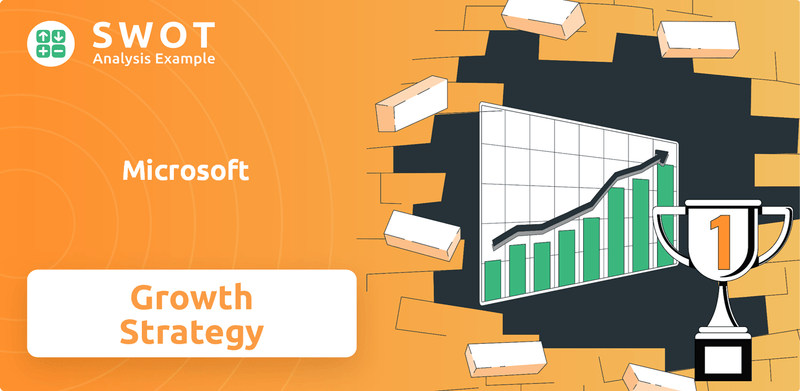
This exploration delves into the Microsoft SWOT Analysis, examining the company's strategic initiatives and potential for future growth. We'll analyze Microsoft's growth strategy, including its focus on innovation and expansion across key sectors like cloud computing and artificial intelligence. Understanding Microsoft's future prospects requires a deep dive into its business model, market share dynamics, and how it plans to navigate the ever-evolving tech landscape.
How Is Microsoft Expanding Its Reach?
The expansion initiatives of the company are primarily focused on increasing its market share in high-growth sectors like cloud computing and AI, while also strengthening its presence in gaming and enterprise solutions. A key component of the company's strategy involves the continuous global expansion of its Azure cloud platform and related services. This includes investing in new data centers and expanding its global footprint to attract more customers and offer innovative cloud solutions. The company's growth strategy is also driven by strategic acquisitions and partnerships.
The company is actively pursuing growth through significant investments in cloud infrastructure. For instance, the company plans to increase its data center investment to $80 billion in 2025, a 44% increase from 2024, with over 50% directed to U.S.-based projects. This aggressive expansion is fueled by partnerships, such as the $10 billion agreement with AI cloud startup CoreWeave and its ongoing collaboration with OpenAI. In Switzerland, the company is upgrading its four data centers near Zurich and Geneva with advanced AI infrastructure to meet growing demand for cloud and AI services, in response to significant increases in Azure OpenAI usage among Swiss customers since mid-2023.
Strategic acquisitions are also a key driver of the company's growth. In fiscal year 2024, the company notably acquired Activision Blizzard King, positioning the company for further expansion in the gaming industry. Following this acquisition, the company aims to develop new gaming experiences, expand its Xbox Game Pass subscription service, and explore opportunities in cloud gaming and the metaverse. The company is also expected to pursue further acquisitions in fiscal year 2025, potentially focusing on cybersecurity and communication, aligning with its broader strategy of offering comprehensive solutions. The company's focus on enterprise software, exemplified by Office 365 and Dynamics 365, continues to present a lucrative opportunity, with Dynamics 365 showing impressive double-digit growth of 11% in Q3 FY2025, supported by increased adoption of AI-powered business applications.
The company is heavily investing in its Azure cloud platform, including new data centers and global expansion. This is driven by the increasing demand for cloud services and AI solutions. The company plans to increase its data center investment significantly in 2025, reflecting its commitment to cloud infrastructure.
Acquisitions, such as Activision Blizzard King, are a key part of the company's growth strategy, particularly in the gaming sector. Further acquisitions are anticipated in areas like cybersecurity and communication. These acquisitions aim to broaden the company's portfolio and market reach.
The company's enterprise software offerings, like Office 365 and Dynamics 365, continue to show strong growth. Dynamics 365, in particular, is experiencing double-digit growth, boosted by the adoption of AI-powered business applications. This underscores the company's focus on enterprise clients.
Partnerships, such as the $10 billion agreement with CoreWeave and collaboration with OpenAI, are crucial for driving innovation and expanding cloud services. The company is also upgrading data centers with AI infrastructure to meet the rising demand for advanced cloud and AI services. The company's success is also influenced by its Marketing Strategy of Microsoft.
The company's growth strategy involves significant investments in cloud computing, strategic acquisitions, and the enhancement of enterprise solutions. These initiatives are aimed at increasing market share and driving innovation across various sectors.
- Expansion of Azure cloud platform through data center investments and global footprint.
- Strategic acquisitions to expand into gaming, cybersecurity, and communication.
- Continued growth in enterprise software, particularly Dynamics 365, with AI integration.
- Partnerships to drive innovation and meet the increasing demand for AI and cloud services.
Microsoft SWOT Analysis
- Complete SWOT Breakdown
- Fully Customizable
- Editable in Excel & Word
- Professional Formatting
- Investor-Ready Format
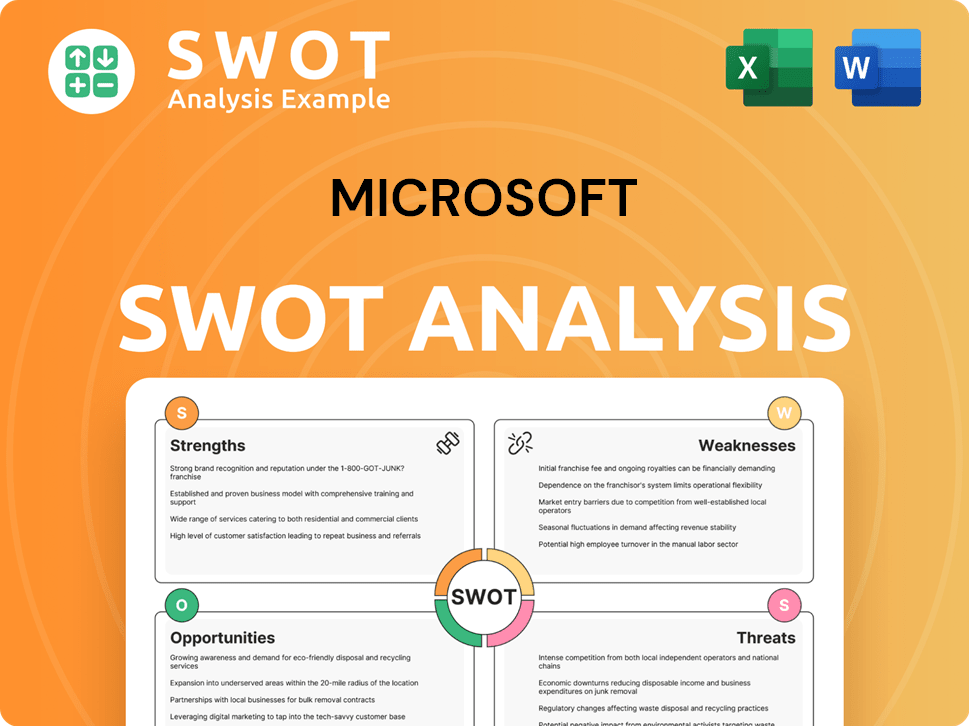
How Does Microsoft Invest in Innovation?
The company's growth strategy heavily relies on innovation and technology, driving sustained expansion through substantial investments in research and development, internal development, and strategic partnerships. A key element of this strategy involves integrating AI capabilities across its product suite to enhance appeal to enterprise customers and create added value. This includes embedding AI into productivity tools like Microsoft 365, enhancing cloud services with AI-powered features, and developing new AI-driven products and solutions.
The company anticipates AI becoming the foundation for intelligent business systems, decision-making, and customer engagement by 2025. The integration of AI features, such as Copilot in Microsoft 365, has been central to driving customer engagement and upsell opportunities, deepening the value proposition of Office apps like Word, Excel, and Outlook. This approach allows the company to maintain and expand its market share in key sectors.
The company's commitment to AI is further demonstrated by its plan to invest $80 billion in AI-enabled data centers globally in 2025. This investment aims to build capacity for AI training and cloud-based applications. The company is also focused on the 'democratization of AI,' making these technologies more accessible to individuals and organizations worldwide. This includes advancements in natural language processing and machine learning models to enhance both productivity tools and consumer applications.
The company is deeply integrating AI into its products. This includes tools like Copilot in Microsoft 365, enhancing its value proposition. This strategy is central to driving customer engagement and increasing sales opportunities.
The company plans to invest $80 billion in AI-enabled data centers worldwide in 2025. This investment is aimed at expanding capacity for AI training and cloud-based applications. This expansion supports the company’s long-term financial goals.
The company is focused on making AI technologies more accessible. This includes advancements in natural language processing and machine learning. This strategy aims to enhance both productivity tools and consumer applications.
The company is making significant strides in quantum computing through Azure Quantum. The goal is to make quantum computers more accessible for real-world applications. Plans include integrating quantum tools with Azure.
The company is expanding its edge computing capabilities. This supports real-time data processing for applications in smart cities and autonomous vehicles. This expansion is crucial as IoT devices proliferate.
The company is leading in green cloud initiatives. This includes improving the energy efficiency of its data centers. The company aims to become carbon-negative by 2030.
Beyond AI, the company's innovation strategy extends to other cutting-edge technologies. The company is making significant strides in quantum computing, with advancements in Azure Quantum, its cloud-based quantum platform. The company aims to make quantum computers more accessible for real-world applications, with plans to integrate quantum tools with Azure. Additionally, the company is expanding its edge computing capabilities as IoT devices proliferate, enabling real-time data processing for applications in smart cities, autonomous vehicles, and industrial automation. The company is also leading in green cloud initiatives, improving the energy efficiency of its data centers and leveraging renewable energy sources as part of its commitment to becoming carbon-negative by 2030. The company's proactive security initiatives, such as the Zero-Day Quest, a $4 million hacking challenge to identify vulnerabilities in its cloud technologies, demonstrate its leadership in cybersecurity innovation. For more details, you can explore the company's business model and strategic approach in this article about the company's growth strategy.
The company's innovation strategy encompasses various cutting-edge technologies, including quantum computing, edge computing, and green cloud initiatives. These advancements are critical for its future prospects and market share expansion.
- Quantum Computing: Advancements in Azure Quantum to make quantum computers accessible.
- Edge Computing: Expanding capabilities for real-time data processing in IoT applications.
- Green Cloud Initiatives: Improving energy efficiency and using renewable energy sources.
- Cybersecurity: Proactive initiatives like the Zero-Day Quest to enhance cloud security.
Microsoft PESTLE Analysis
- Covers All 6 PESTLE Categories
- No Research Needed – Save Hours of Work
- Built by Experts, Trusted by Consultants
- Instant Download, Ready to Use
- 100% Editable, Fully Customizable
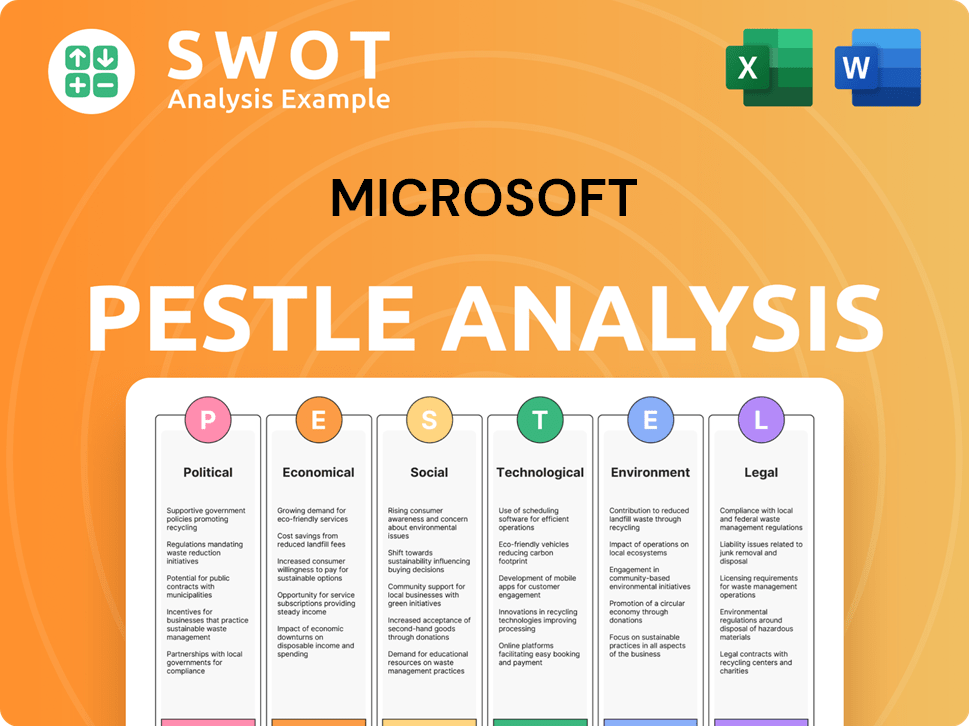
What Is Microsoft’s Growth Forecast?
The financial outlook for Microsoft remains robust, driven primarily by its cloud computing and artificial intelligence (AI) segments. Analysts project sustained strong financial performance for fiscal year 2025. This positive outlook is supported by strategic investments and a focus on innovation, positioning the company for continued growth in key markets.
For fiscal year 2025, analysts anticipate an earnings per share (EPS) of $13.30, representing a 12.71% increase over fiscal year 2024. Revenue is projected to achieve a healthy year-over-year growth of 12-15%. These projections reflect the company's ability to capitalize on market trends and maintain its competitive edge. The company's financial health is further underscored by its ability to generate substantial returns for shareholders.
In its fiscal third quarter of 2025 (ended March 31, 2025), Microsoft reported revenue growth of 13% year-over-year, reaching $61.9 billion. The Intelligent Cloud segment, which includes Azure, surged by 21%, with Azure alone growing 33% year-over-year on a constant currency basis. This growth highlights Microsoft's strong position in the cloud market and its ability to drive significant revenue from its cloud services. The company's growth strategy is heavily focused on expanding its cloud infrastructure and services to meet the increasing demand from businesses worldwide.
Microsoft's total annual revenue for 2024 was $245.1 billion, a 15.67% increase from 2023. The company's operating income reached $109.4 billion, demonstrating strong operational efficiency. These figures reflect the company’s ability to generate substantial revenue and maintain profitability across its diverse business segments.
The net income for 2024 was $88.1 billion, with a net profit margin of 35.86%. The company's average net profit margin for 2024 was 35.86%, a slight decline from 2023 but still robust. Microsoft's gross profit margin for fiscal year 2024 was 69.76%, indicating strong cost management and pricing power.
The company's capital expenditures (capex) are projected at $80 billion for fiscal year 2025, a 44% increase from the prior year. This significant investment is primarily to support AI and cloud infrastructure. This reflects Microsoft's commitment to expanding its infrastructure to support its growth strategy and meet the increasing demand for its services.
Microsoft returned $8.4 billion to shareholders in the form of share repurchases and dividends in the fourth quarter of fiscal year 2024. The company announced a total annual dividend of $3.00 per share for fiscal year 2024, a 10% increase from FY23. This commitment to shareholder value is a key component of Microsoft's financial strategy.
Analysts forecast that AI revenue could exceed $50 billion by fiscal year 2027, highlighting the company's aggressive push into this high-growth sector. Owners & Shareholders of Microsoft can expect continued innovation and expansion in the AI space.
- Microsoft's growth strategy is heavily reliant on its AI capabilities.
- The company is investing heavily in AI research and development.
- The expansion in the Asia-Pacific region is a key area for future growth.
- Microsoft is adapting to changing consumer behavior.
Microsoft Business Model Canvas
- Complete 9-Block Business Model Canvas
- Effortlessly Communicate Your Business Strategy
- Investor-Ready BMC Format
- 100% Editable and Customizable
- Clear and Structured Layout
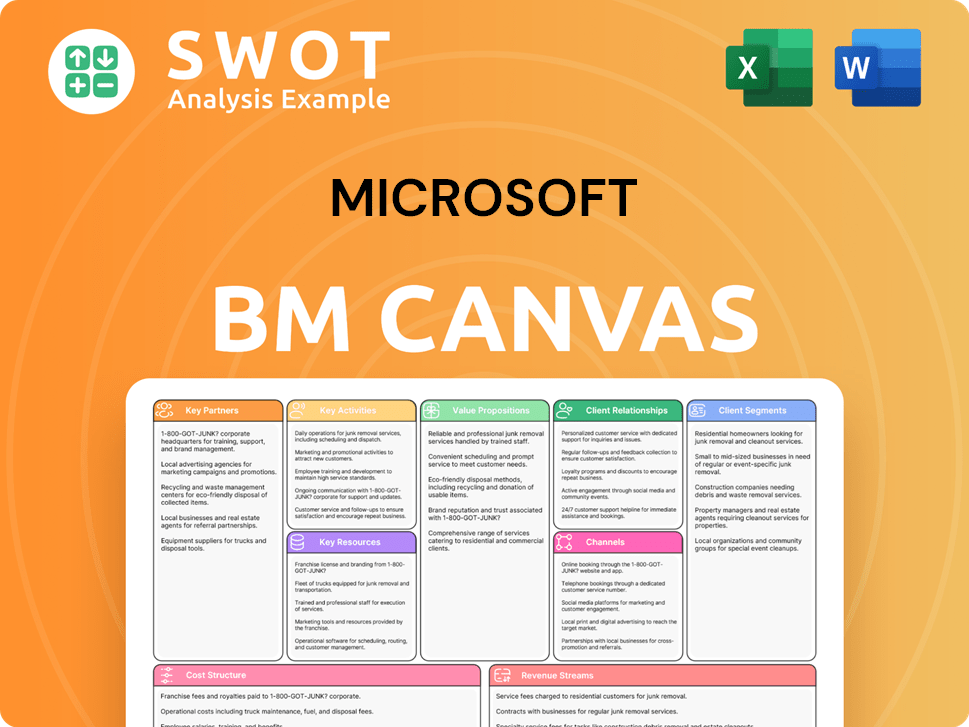
What Risks Could Slow Microsoft’s Growth?
The growth trajectory of Microsoft faces several risks that could impact its ambitious plans. Competition in the cloud computing sector, particularly from rivals like Amazon Web Services (AWS) and Google Cloud, presents a constant challenge. Furthermore, evolving regulations and the rapid pace of technological advancements introduce additional layers of complexity.
Regulatory changes and data security concerns are significant obstacles. The company must navigate the evolving global landscape of AI regulations, such as the European Union's AI Act. Supply chain vulnerabilities and the need to adapt to technological disruptions also pose ongoing challenges for Microsoft's operations.
Microsoft’s ability to maintain its growth depends on how effectively it manages these risks. This involves strategic diversification, robust risk management, and proactive scenario planning to ensure sustained success in a dynamic market environment. Understanding the Competitors Landscape of Microsoft is also crucial for navigating these challenges.
Intense competition in cloud computing, particularly from AWS and Google Cloud, threatens Azure's growth. The emergence of cost-efficient AI models also challenges the sustainability of Microsoft's infrastructure investments in AI. Microsoft's market share in cloud computing is closely watched by investors.
The global AI sector faces increasing regulatory pressure, as seen with the EU's AI Act. In March 2024, the U.S. House of Representatives banned staff from using Copilot due to data security concerns. Generative AI tools were responsible for 40% of data security incidents in 2024.
Organizations have experienced delays in rolling out Microsoft 365 Copilot due to security concerns, with 60% of Gartner respondents identifying risky default configurations. These challenges highlight the need for robust security measures and careful deployment strategies. Data security is a critical aspect of Microsoft’s business model.
Economic uncertainty is causing businesses to be more cautious in their spending on cloud computing and AI services. While Microsoft is less exposed to tariffs, broader economic trends influence demand. Microsoft's long-term financial goals are affected by these conditions.
The end of support for Windows 10, Office 2016, and Office 2019 on October 14, 2025, could expose systems to cyber threats. The unpredictability of pricing for Microsoft Unified Support, which could cost significantly more, presents a financial risk. These disruptions could impact Microsoft's growth strategy.
Internal resource constraints and challenges in scaling emerging technologies could limit revenue. Delayed breakthroughs in key areas can also hinder growth. Microsoft's innovation efforts are vital for its future prospects.
Microsoft addresses these risks through diversification, risk management frameworks, and scenario planning. The company's diversified revenue streams and strong cash flow generation provide resilience against economic headwinds. Microsoft's business model for software as a service helps it adapt to changing consumer behavior.
Microsoft emphasizes building trustworthy AI that prioritizes cybersecurity, privacy, and digital safety. Addressing these concerns is crucial for maintaining customer trust and ensuring long-term growth. How Microsoft is innovating in cybersecurity is a key factor.
Microsoft Porter's Five Forces Analysis
- Covers All 5 Competitive Forces in Detail
- Structured for Consultants, Students, and Founders
- 100% Editable in Microsoft Word & Excel
- Instant Digital Download – Use Immediately
- Compatible with Mac & PC – Fully Unlocked
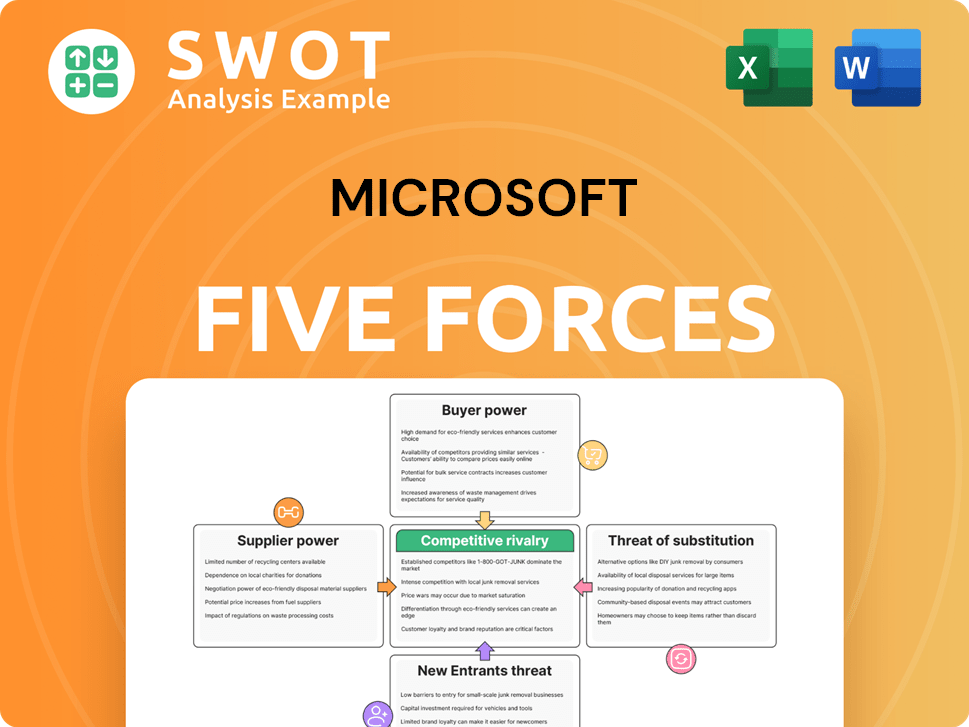
Related Blogs
- What are Mission Vision & Core Values of Microsoft Company?
- What is Competitive Landscape of Microsoft Company?
- How Does Microsoft Company Work?
- What is Sales and Marketing Strategy of Microsoft Company?
- What is Brief History of Microsoft Company?
- Who Owns Microsoft Company?
- What is Customer Demographics and Target Market of Microsoft Company?
Disclaimer
All information, articles, and product details provided on this website are for general informational and educational purposes only. We do not claim any ownership over, nor do we intend to infringe upon, any trademarks, copyrights, logos, brand names, or other intellectual property mentioned or depicted on this site. Such intellectual property remains the property of its respective owners, and any references here are made solely for identification or informational purposes, without implying any affiliation, endorsement, or partnership.
We make no representations or warranties, express or implied, regarding the accuracy, completeness, or suitability of any content or products presented. Nothing on this website should be construed as legal, tax, investment, financial, medical, or other professional advice. In addition, no part of this site—including articles or product references—constitutes a solicitation, recommendation, endorsement, advertisement, or offer to buy or sell any securities, franchises, or other financial instruments, particularly in jurisdictions where such activity would be unlawful.
All content is of a general nature and may not address the specific circumstances of any individual or entity. It is not a substitute for professional advice or services. Any actions you take based on the information provided here are strictly at your own risk. You accept full responsibility for any decisions or outcomes arising from your use of this website and agree to release us from any liability in connection with your use of, or reliance upon, the content or products found herein.